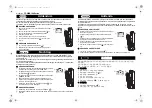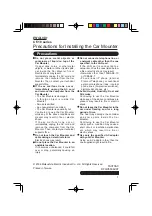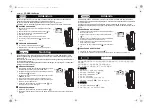
2
2.1 Part A- LCD
A1: Time
A2: Radio Control Icon
A3: Date /Alarm Time 1
A4: Temperature/Alarm Time 2
A5: Projection Time
2.2 Part B- Buttons
B1: “Alarm Time1” button
B2: “MODE” button
B3:”+” button
B4: “RESET” button
B5: “-“button
B6: “ALARM” button
B7: “Alarm Time 2” button
B8: “PROJECTION” button
B9: “SNOOZE/ DIMMER” button
2.3 Part C- Structure
C1: Adaptor Plug (4.5V, 150mA)
C2: Projection Focus Ring
3. Getting Started:
Connect the power cord to the wall outlet and place the unit on flat surface.
4. Time and Alarm Setting
4.1 Radio Controlled Clock:
After main unit finishes receiving the transmission from outdoor sensor, the clock
automatically starts to scan the DCF time signal. Radio control icon“
” flashes on the
LCD.
flashes
,
Indicating now is receiving
DCF signal
turns on,
Indicating signal received
successfully
disappear,
Indicating signal reception
failed
The clock automatically scans the time signal at 3.00 a.m. every day to maintain accurate
timing. If reception fail, scanning stops (“
” on LCD disappear) and repeats again at
4.00 a.m. and 5.00a.m.
The clock can be set to scan the time signal manually by holding “+”& “-“buttons (B3&B5)
for 2 seconds. Each reception takes about several minutes. If receptions fail, scanning
stops. (“
” on LCD disappear)
Stop scanning by holding “+”& “-“buttons (B3&B5) for 2 seconds
“
” shown on the LCD means it is in Daylight Saving Time Mode.
4.2 Manual Time Setting:
After start-up, hold “MODE” button (B2) for 3seconds to enter settings.
Press “+” or “-” button (B3&B5) to change setting. Press “MODE” (B2) to confirm and
move to the next setting.























